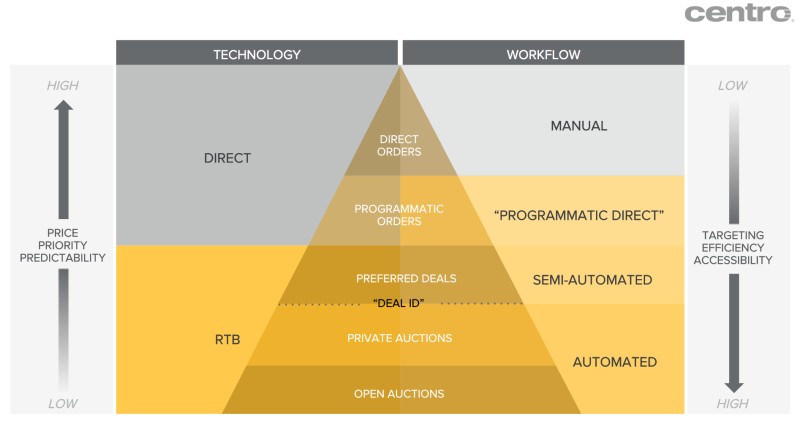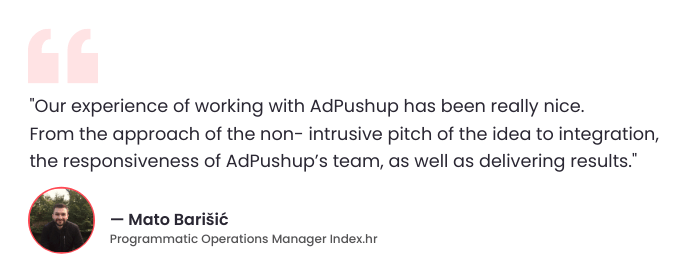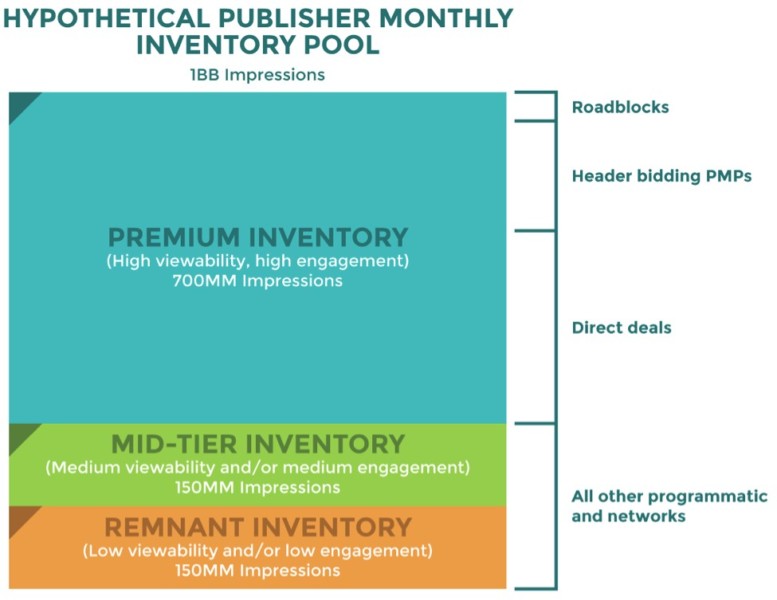Not all buyers are created equal. For that matter, neither are your ad impressions.
There’s more to selling your inventory than signing up with AdSense.
Savvy publishers will often silo their inventory and sell it via multiple channels to get the best value for every available impression. You’ve got:
- Semi-automated programmatic deals: Programmatic preferred (no fill rate commitment) and Programmatic guaranteed (fixed fill rate) are one-on-one deals with buyers for specific inventory packages at pre-negotiated CPM.
- Automated RTB: Real-time open and private auctions. Highly scalable and less resource-intensive model for selling impressions (and not just the remnant kind).
- Direct deals: There are also direct orders (manual direct deals) for native ads (roadblocks, sponsored content, page takeovers, etc.).
And that’s without even throwing header bidding into the mix.

How these techniques are prioritized is determined by types of impressions and buyers — with the goal being to sell every impression at best price.
This is called an ad stack.
In this post, we take a look at a few strategies publishers use to sell their inventory to the right buyers.
The Metrics
There’s an oversupply of impressions and not enough demand. Your primary goal is to maximize eCPM and sell every last impression in your inventory pool. This requires demand sources that can guarantee high enough:
1. Fill rate: Number of ads served / number of impressions offered. And although some industry players brag about ‘100% fill rates’, those are impossible to achieve for factors that are sometimes outside publisher control—highly specific targeting, network timeouts, (ad) network response times, available demand for your impressions, and your own high bounce rate could lower your fill rate.
In your inventory pool, you have impressions with different fill potential. iOS and Android impressions for US audience, for instance, will have more demand (and therefore, higher fill rates) than other demographics.
Your goal is to reach as close to 100% fill rate as possible. This calls for page speed optimization on your part and ensuring low response times from your networks and demand partners.
2. Bid density: Bid density is the sheer volume of bids taking place on an inventory type. Higher bid density means more competition among bidders, which means higher revenue for publisher.
Different networks and exchanges will have varying bid densities, depending on the number of demand partners they integrate with (even though as much as 80% of all programmatic demand comes from a few major partners).
Whether you’re a large, ComScore 1000 publisher or a smaller, DIY blogger with under 10K monthly pageviews, you can gain value from programmatic advertising by aligning yourself with quality, publisher-focused ad networks.
There are other considerations like available ad formats, compensation methods, niches, and more. We covered these in a previous post: 5 things you need to consider when choosing an ad network.
The Constraints
Publishers implement price floors and timeouts to balance revenue and UX.
How do you optimize price floors? It depends on how correctly you can value your own ad space. Some publishers jack up floor prices for higher CPM, but that comes with its own risk (reduced competition and unfilled impressions) which means revenue lost for everyone.
The optimization team at Sovrn recommends keeping up with expected CPMs inside the ad server and focusing more on maximizing fill rate instead of restricting access to inventory.
A price floor is not an evaluation of inventory, it’s simply a baseline amount that decides who gets to bid on your inventory. A higher price floor only limits the bidders who see and bid on impressions.
What about latency? A major publisher concern (regardless of header bidding) is latency—where demand sources take too long to fill an impression and the user has already scrolled past (lost viewable impression) or bounced away (in case the ads are not set to load asynchronously and user had to wait for content).
Ben Kneen makes a great case for settling this issue with timeouts, and offers a suggestion on how to optimize for it:
To be fair, latency can be a problem, but more on the exchange side, as many providers may not be able to respond with a valid bid unless the timeout setting sits at a certain (high enough) level. My recommendation therefore would be for publishers to measure response rate at the timeout tolerance as the key metric.
Demand Differentiation
Top ad networks and exchanges will usually have some publisher guidelines in place to ensure fair value to their individual advertising partners. For instance, AppNexus, OpenX, Sovrn, AOL, Index Exchange, and many others are certified under TAG’s IAB-authored Inventory Quality Guidelines initiative.
These companies give greater brand safety assurances to advertisers, which means they will not put up with low-quality inventory or ads appearing next to content they deem inappropriate.
These networks also have some sort of, as one publisher calls it, demand differentiation. Within (and out of) header bidders, some networks will bid higher for a particular type of impression than others.
- Video: Publishers offering video inventory for sale should select bid partners who have demand for it, like Index, SpringServe, Sekindo, HiroMedia, etc.
- Amazon: Affiliate content and product review publishers can get Amazon demand from A9.
- Mobile: Yieldbot bids on mobile impressions.
- Brand Advertisers: Index Exchange partners with major DSPs and curates demand for choice publishers.
- Server-side Header Bidding: OpenX, A9, Index Exchange, are already taking header bidding server side.
The key to a successful long-term publisher strategy is to partner with DSPs, networks, and exchanges that bring substantial amounts of unique demand to bid on the impressions. This reduces demand cannibalization, reduces intermediaries, and keeps bids competitive.
Before you can integrate with (m)any of these networks, you’ll have to reach a minimum bar on monthly pageviews. There may be other requisites (especially for niche ad networks).
Note: Most networks have their own ways of identifying Non-human IVT (Invalid Traffic) from real impressions, so jacking up your pageviews with third party sources filled with bot farms may end up with you getting blacklisted forever.
Now, assuming you do have enough pageviews to qualify, you will need sophisticated programmatic know-how for a tech stack that would efficiently execute direct deals, daisychaining (now replaced with Header Bidding PMPs), and finally, for the remaining inventory, open or private RTB auctions.

Strategies
Tier A Publishers (comScore 500) can usually bypass the networks / exchanges and integrate directly with premium brands to sell selective inventory (of brand advertisers’ choice) at a pre-negotiated fill-rate and CPM. These are direct deals. You’ll need a dedicated sales rep for these.
Let’s take a hypothetical example of The Huffington Post, which sets up direct deal with, say, Thomas Cook, to fill Above-the-fold vertical rectangles on all content pages in the website’s Travel section; at $12 CPM, 100% fill rate, for 50M pageviews.
Note: Before Header Bidding, executing this (and other direct deals) would ideally be an ad server’s top priority. With header bidding wrapper in place, bids from other demand sources can compete (and win) against direct-deal CPM on an impression-level.
This would usually be followed by a daisychain of networks (a.k.a. waterfall) and RTB (open as well as private) for remnant inventory with ‘100% fill’ vendors like AdSense and OpenX.
Nowadays, the execution priority goes like this: Native (roadblocks, page skins, and the like) > Header Bidding > Direct Deals > RTB (other programmatic). A hypothetical pool of 1 Billion impressions would be divided up as follows.

Those looking for scale and a less tedious solution (for premium inventory, that is) than direct deals will find PMPs useful: Private auctions between multiple partners (of your choice) that work on the same infrastructure as RTB. Take a look at our guide to PMPs for further insight on what you’ll need and some ideas on packaging inventory.

Shubham is a digital marketer with rich experience working in the advertisement technology industry. He has vast experience in the programmatic industry, driving business strategy and scaling functions including but not limited to growth and marketing, Operations, process optimization, and Sales.







